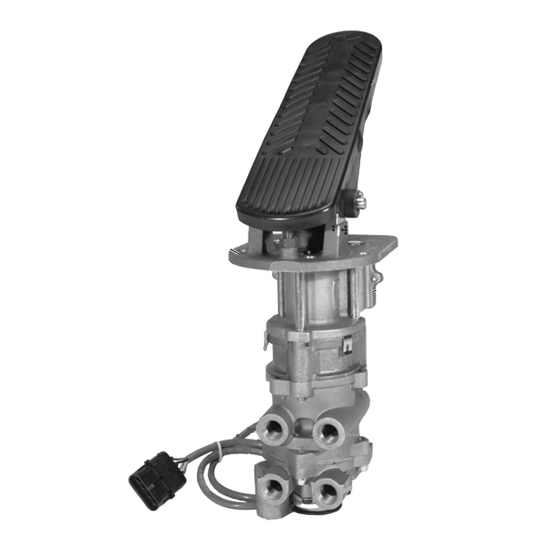BENDIX E-10PR RETARDER CTRL BRAKEVALVE Manual - Página 4
Procurar online ou descarregar pdf Manual para Unidade de controlo BENDIX E-10PR RETARDER CTRL BRAKEVALVE. BENDIX E-10PR RETARDER CTRL BRAKEVALVE 8 páginas. Retarder control brake valve

SERVICE CHECKS
OPERATING CHECK
Check the delivery pressure of both primary and secondary
circuits using accurate test gauges. Depress the treadle to
several positions between the fully released and fully applied
positions, and check the delivered pressure on the test
gauges to see that it varies equally and proportionately with
the movement of the brake pedal.
After a full application is released, the reading on the test
gauges should fall off to zero promptly. It should be noted
that the primary circuit delivery pressure will be about 2 PSI
greater than the secondary circuit delivery pressure with
both supply reservoirs at the same pressure. This is normal
for this valve.
Important: A change in vehicle braking characteristics or a
low pressure warning may indicate a malfunction in one or
the other brake circuit, and although the vehicle air brake
system may continue to function, the vehicle should not be
operated until the necessary repairs have been made and
both braking circuits, including the pneumatic and
mechanical devices, are operating normally. Always check
the vehicle brake system for proper operation after performing
brake work and before returning the vehicle to service.
LEAKAGE CHECK
1. Make and hold a high pressure (80 psi) application.
2. Coat the exhaust port and body of the brake valve with a
soap solution.
3. Leakage permitted is a 1" bubble in 3 seconds. If the
brake valve does not function as described above or
leakage is excessive, it is recommended that it be
replaced with a new or remanufactured unit, or repaired
with genuine Bendix parts available at authorized Bendix
parts outlets.
REMOVAL - Refer to figures 3 and 4 for item
numbers referenced in parenthesis.
1. Chock the vehicle wheels or park the vehicle by
mechanical means. (Block and hold vehicle by means
other than air brakes.) Drain all air system reservoirs.
REMOVAL OF THE RETARDER CONTROL ASSEMBLY
1. Disconnect the plug of the electrical cable from its mating
socket of the vehicles power supply.
2. Identify and disconnect all air supply and delivery lines at
the brake valve if brake valve replacement is required.
3. Remove the brake valve and treadle assembly from the
vehicle by removing the three cap screws on the outer bolt
circle of the mounting plate.
NOTE: Before removing the treadle assembly, be sure to
mark the position of the treadle mounting plate
relative to the retarder control assembly.
4
4. Remove the treadle from the mounting plate by tapping
out the roll pin and then the pin retaining the treadle,
spring and mounting plate.
NOTE: Mark the position of the retarder control assembly to
the upper valve housing.
5. Remove the boot from the plunger.
6. Remove the three remaining cap screws (2) from the
mounting plate. Separate the mounting plate from the
retarder control section (1) and the retarder control
section from the upper valve housing (13). CAUTION: Do
Not separate the upper valve housing from the
balance of the brake valve. Keep the plunger in the
retarder control section in its bore. Switch damage
will result from attempted removal or permitting it
to slide out of the body/bore by more than 3/8".
DISASSEMBLY - Refer to figures 3 and 4 for item
numbers referenced in parenthesis.
1. If the entire brake valve and treadle assembly was
removed from the vehicle, remove the three cap screws
securing the treadle assembly to the basic brake valve.
2. Remove the screw (15) securing the exhaust diaphragm
(17) and washer (16) to the exhaust cover (18).
3. Remove the four screws that secure the exhaust cover
(18) to the lower body.
4. Remove the secondary inlet and exhaust valve assembly
(19) from the lower body.
5. Remove the four hex head cap screws securing the lower
body to the upper body and separate the body halves.
6. Remove the rubber seal ring (21) from the lower body.
7. While depressing spring seat (5), remove retaining ring
(4). Remove spring seat (5) and coil spring (6).
Caution: Before proceeding with the disassembly, refer
to Figures 3 and 4 and note that the lock nut (7) and
stem (22) are used to contain the primary piston return
spring (12), stem spring (9), and the relay piston spring
(27). The combined force of these springs is
approximately 50 pounds and care must be taken when
removing the lock nut as the spring forces will be
released. It is recommended that the primary piston and
relay piston be manually or mechanically contained while
the nut and stem are being removed.
8. Using a 3/8" wrench, hold the lock nut (7) on the threaded
end of the stem (22). Insert a screwdriver to restrain the
stem, remove the lock nut (7), spring seat, (8) and stem
spring (9).
9. Remove adapter (13) and o-ring (14). Remove the primary
piston (11) from adapter (13) and o-ring (10) from the
primary piston (11).
10. Remove the relay piston (24), relay piston spring (27),
primary piston (11) and primary piston return spring (12)
from the upper body. Use care so as not to nick seats.
